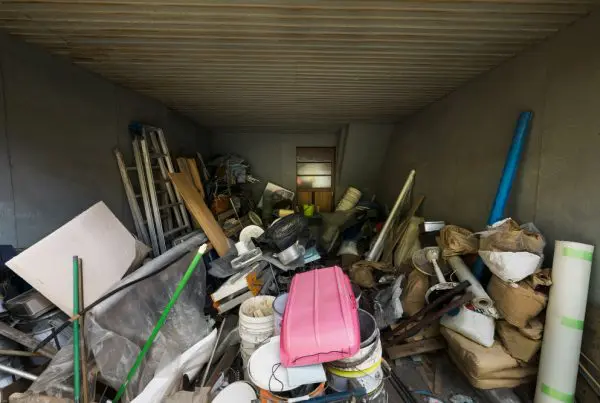Flipping a hoarder house is not for the faint of heart; it’s a thrilling roller-coaster ride filled with unexpected challenges and unparalleled rewards. Imagine stepping into a world where every room unveils a new mystery, where beneath layers of forgotten memories lie hidden treasures waiting to be uncovered.
Dive in, and let’s unravel the secrets of turning a hoarder’s haven into a dream home.
Key Takeaways
- Flipping a hoarder house offers unique challenges, from extensive cleanup to navigating emotional complexities with sellers.
- Assembling a team of professionals, including cleaning companies and rehab experts, is crucial for a successful transformation.
- Addressing potential buyer concerns about the house’s history is vital to dispel stigmas and ensure a smooth sale.
- Investing wisely in quality renovations and repairs can significantly increase the property’s market value and appeal.
- With the right approach and strategy, flipping a hoarder’s home can lead to substantial profits and the satisfaction of breathing new life into a neglected property.
Understanding Hoarding
Hoarding is a psychological condition where an individual accumulates items to an excessive degree, often resulting in clutter that can render living spaces unusable. This disorder goes beyond the typical collection of items; it’s an overwhelming urge to save items, regardless of their value.
At its core, a hoarder is someone who struggles to part with possessions, fearing they might need them in the future. This accumulation can range from boxes upon boxes of paperwork to floor to ceiling stacks of “junk”. The hoarding house becomes a maze of items, often leading to areas blocked off due to the items blocking pathways or rooms filled from ceiling with stuff.
The psychological implications of hoarding can be profound. It’s estimated that 1.52% to 4.25% of the population may exhibit hoarding behaviors. The reasons behind hoarding can vary, but often, it’s tied to traumatic events, anxiety, or depression. For homeowners, the impact is multifaceted.
A hoarder home can become a safety hazard with
- Risks of fire
- Structural damages
- Health issues due to mold and pests
- Emotional toll on the hoarder and their families
For those in the flipping houses business or those wanting to renovate their first house, a hoarder’s house presents both challenges and opportunities. The house may require extensive clean-out, teardown, or renovation. However, due to the issues faced by the homeowner, these properties often come at a low price, allowing the investor to purchase the home and sell for a profit after renovations.
Why Flip a Hoarder House?
(Youtube Video: What’s it like to buy a Hoarder House?)
One of the primary reasons to buy a hoarder house and venture into this niche is the unique opportunities it presents. Given the condition of a typical hoarder home, many potential buyers or investors shy away from such projects.
This less competition in the market can lead to the property being available at a significantly low price. For those willing to take on the challenge, this means the ability to purchase the home at a cost much below its potential market value after renovations.
The potential for a large profit margin is undeniable. Once the clean-out, renovation, and necessary repairs are done, the transformation can be astonishing. What was once a house filled from floor to ceiling with stuff can become a sought-after property in the real estate market.
The difference between the buying low price and the selling price post-renovation can lead to substantial profits for the investor.
Moreover, flipping a hoarder’s house is not just about the financial gains. It’s also about bringing a property back to life, turning what might be seen as a neighborhood eyesore into a beautiful, livable space. For many, the satisfaction of such a transformation, both in terms of aesthetics and the positive impact on the community, is a reward in itself.
Challenges of Flipping a Hoarder House
Flipping houses is a venture that comes with its set of challenges, but when it comes to a hoarder’s house, the obstacles can be particularly daunting. Here are some of the primary challenges faced by investors and flippers:
Volume of Items
One of the most immediate challenges is the sheer volume of items. A hoarder home is often filled from floor to ceiling with stuff, with boxes upon boxes of possessions. This clutter leads to items blocking pathways, rooms, and sometimes even essential utilities. The task of sorting through these items, deciding what to keep, discard, or sell, can be overwhelming.
Damage and Repairs
Beneath the clutter, one might be surprised by the extent of damage a hoarder house may have endured. Issues like water damage, rot, and structural problems are common. The house might be damaged in areas that have been inaccessible for years due to the items blocking access. As a result, flipping the house often requires extensive repairs, sometimes even a teardown or taking the house down to the studs for a complete overhaul.
Pests and Biohazards
With the accumulation of items, especially organic matter like food or waste, pests such as rodents and insects find a conducive environment to thrive. Additionally, the presence of feces, mold, and other biohazards can pose significant health risks. Addressing these issues requires professional help and sometimes specialized cleaning services.
Time-Consuming Cleanup
The cleanup process for a hoarder house can be overwhelming. It’s not just about removing the “junk” but also about ensuring the property is safe and habitable. This process is often time-consuming, and investors might need to spend on services like dumpster rental for efficient waste management.
Psychological Aspects
Beyond the physical challenges, there’s a psychological dimension to consider. A hoarder is someone with deep emotional attachments to their possessions, often stemming from traumatic experiences or mental health conditions.
Preparing for the Flip
Embarking on the journey of flipping a hoarder’s house requires meticulous preparation. Here’s a guide to ensure investors and flippers are well-equipped for the task ahead:
1. Initial Assessment
Before diving into the project, it’s crucial to conduct a thorough assessment of the hoarder home. This involves understanding the volume of items present and gauging the potential damage beneath the clutter.
By doing so, investors can ensure they don’t be surprised by unforeseen challenges. It’s also an opportunity to identify items worth salvaging or selling, which can offset some of the renovation costs.
2. Safety First
Flipping houses, especially a hoarder’s house, can pose various health and safety risks. From mold and pests to sharp objects and unstable structures, the hazards are plenty. It’s paramount to wear protective clothing, including gloves, masks, and safety goggles.
Ensuring good air quality is also vital, especially when dealing with mold, dust, or other airborne contaminants. Using air purifiers or ensuring proper ventilation can mitigate these risks.
3. Budgeting
One of the most critical aspects of preparing for the flip is budgeting. Given the unique challenges a hoarder house presents, investors must be prepared for unexpected expenses. Estimating repair costs, from basic clean-out to extensive renovations, is essential.
Additionally, setting aside a contingency fund can help address unforeseen challenges, ensuring the project doesn’t stall due to financial constraints.
The Cleanup Process
The cleanup of a hoarder’s house is arguably the most daunting phase of the flipping process. It requires a combination of manual labor, strategic planning, and sometimes, specialized expertise. Here’s a breakdown of the steps involved:
1. Professional Cleaning
Given the magnitude of the task, it’s often wise for investors and flippers to hire a professional cleaning service. These experts come equipped with the necessary tools and materials to handle the unique challenges a hoarder home presents.
From navigating the volume of items to ensuring the clutter is removed efficiently, their expertise can save time and reduce potential hazards.
2. Junk Removal
Once the initial cleaning is underway, the next step is junk removal. This involves sorting through the “junk”, categorizing items for disposal, recycling, or donation. Efficient junk removal ensures that the property is cleared, making it easier to assess and address any underlying damages.
3. Specialized Cleaning
Beyond the visible clutter, a hoarder house often hides more insidious issues like mold, pests, and water damage. Addressing these requires specialized cleaning techniques. Areas affected by mold or water damage need thorough disinfecting, and in severe cases, parts of the house might need to be torn down.
Improving air quality is also paramount, especially in homes where ventilation has been compromised for years.
4. Estate Sales
Amidst the clutter, there’s often a silver lining: items of value. Whether it’s antiques, collectibles, or even everyday items in good condition, these can be sold through estate sales. Organizing an estate sale not only helps recoup some expenses but also ensures that valuable items find a new home instead of ending up in the trash.
Renovation and Repairs
Once the cleanup process is complete, the next phase in flipping a hoarder’s house is the renovation and repairs. This stage is crucial in transforming the property from a cluttered space into a desirable home.
1. Assessing Damage
Before diving into repairs, it’s essential to conduct a thorough assessment of the hoarder house. Often, the damage goes beyond what’s visible to the naked eye. Damage from neglect can be extensive, especially in areas that had items blocking access for prolonged periods. From water leaks to structural weaknesses, understanding the full extent of the damage is crucial for effective renovation.
2. Repair Strategies
The heart of the renovation process lies in the repairs. Key areas of focus include the floors and walls, which might be damaged or stained from years of neglect. Peeling paint, rotting wood, and compromised structural integrity are common issues.
Addressing these requires a combination of cosmetic fixes and more intensive structural repairs. For instance, walls might need repainting, while certain sections might require complete replacement.
3. Investing in Quality
While it’s tempting to opt for quick fixes, especially when working on a tight budget, it’s essential to invest in quality when flipping the house. This ensures that the house is not just visually appealing but also structurally sound and built to last.
High-quality materials and professional workmanship can make a significant difference, ensuring the renovated hoarder home stands out in the real estate market and fetches a good price.
Selling the Hoarder House
After the arduous journey of cleaning, renovating, and repairing a hoarder’s house, the final step in the flipping houses process is the sale. Here’s how to approach this phase:
1. Marketing Strategies
The transformation of a hoarder home into a beautiful, livable space is a compelling story that can be a significant selling point. Highlighting the before-and-after visuals, showcasing the quality of renovations, and emphasizing the value added can attract potential buyers.
Effective marketing strategies can help sell the house for a profit, ensuring that all the hard work and investment pay off.
2. Dealing with Stigma
Despite the extensive renovations, some potential buyers might have reservations about purchasing a house with a history of hoarding. It’s essential to address these concerns head-on.
Offering warranties, sharing documentation of repairs, and being transparent about the property’s history can alleviate concerns. Emphasizing the thorough cleanup, professional renovations, and the house’s current state can help dispel any lingering doubts.
3. Setting the Right Price
Pricing a hoarder home post-renovation can be a bit tricky. While the house has undergone significant improvements, it’s essential to understand the local real estate market and the unique opportunity this property presents. Conducting a comparative market analysis, considering the quality of renovations, and understanding the demand can help set a competitive price.
The goal is to strike a balance between fetching a good return on investment and ensuring the house for sale is attractive to potential buyers.
Expert Tips for Flipping a Hoarder House
Flipping a hoarder’s house is a unique challenge that requires a blend of expertise, patience, and strategy. Here are some expert tips to ensure success in this niche real estate venture:
1. Building a Team
The complexity of transforming a hoarder home demands a collaborative approach. Assembling a team of professionals can make the process smoother and more efficient. Collaborate with cleaning companies that specialize in hoarder situations.
Engage rehab professionals who can address the extensive repairs and renovations required. And, of course, partnering with experienced real estate agents can help in effectively marketing and selling the renovated property.
2. Understanding the Seller
Often, the seller of a hoarder house is not just letting go of a property but also a significant part of their life, filled with memories and emotions. Many hoarders grapple with psychological disorders, and it’s crucial to approach them with compassion and understanding.
Building trust, being patient, and offering support can make the transaction smoother for both parties.
3. Maximizing Profit
The ultimate goal of flipping houses is to generate a profit. When dealing with a hoarder home, this involves a few key strategies. Start by buying low, capitalizing on the reduced competition and potential undervaluation of the property. Invest wisely in renovations, ensuring quality while keeping an eye on the budget.
And when it’s time to sell, position the house effectively in the market to sell high, highlighting its transformation and the value it offers to potential buyers.
Conclusion
Flipping a hoarder’s house is more than just a real estate venture; it’s a journey of transformation. From navigating the emotional complexities of sellers to the tangible challenges of renovation, it’s a unique endeavor that demands expertise, compassion, and strategy. But with the right approach, the rewards can be immense.
Not only can you breathe new life into a neglected property, but you also stand to reap significant profits. Ready to embark on this adventure? Dive into the world of flipping houses and discover the hidden gems waiting to be polished!

Yuval Elkeslasi is a distinguished professional in the finance industry, celebrated for his pioneering strategies and significant contributions as the leader of Hard Money Lenders IO. Hailing from Queens, New York, Yuval has built an impressive career, transforming the lending landscape through his expertise and visionary approach. Yuval Elkeslasi
attended Florida State University, where he obtained a bachelor’s degree in Finance. This academic foundation provided him with the necessary skills and knowledge to thrive in the competitive financial arena. Yuval’s tenure at Hard Money Lenders IO is marked by numerous pioneering accomplishments. He has introduced a variety of loan programs designed to cater to specific client requirements, including fix and flip loans, new construction financing, cash-out refinancing, rental property loans, and specialized financing for luxury items like yachts. Among Yuval’s significant achievements is securing an $8 million construction loan for a spec home builder in Port Royal, Naples. He also orchestrated the financing for a prestigious 72’ 2024 Viking Convertible yacht valued at $7.2 million. These transactions demonstrate Yuval’s adeptness at navigating complex financial landscapes and delivering exceptional results.

